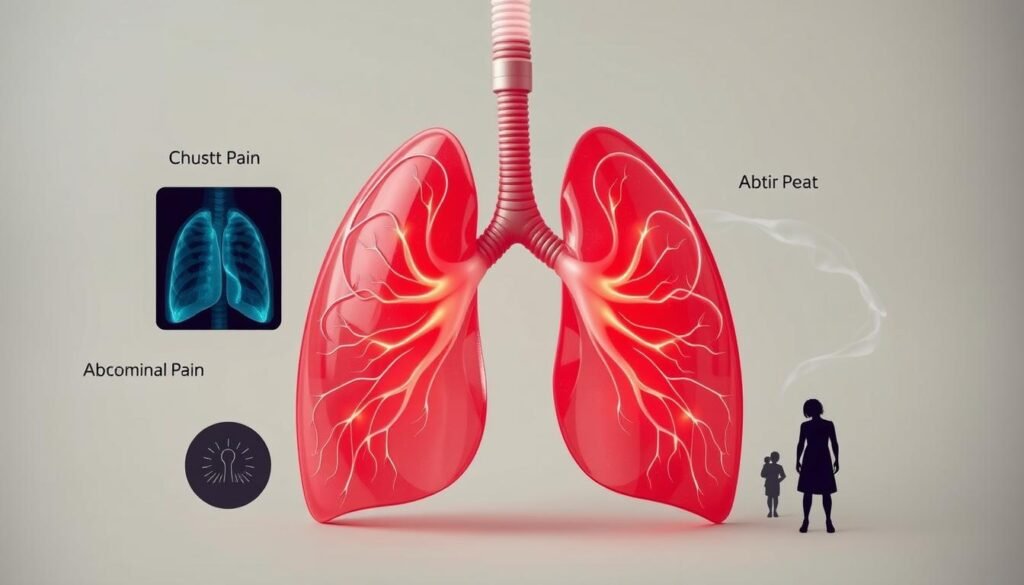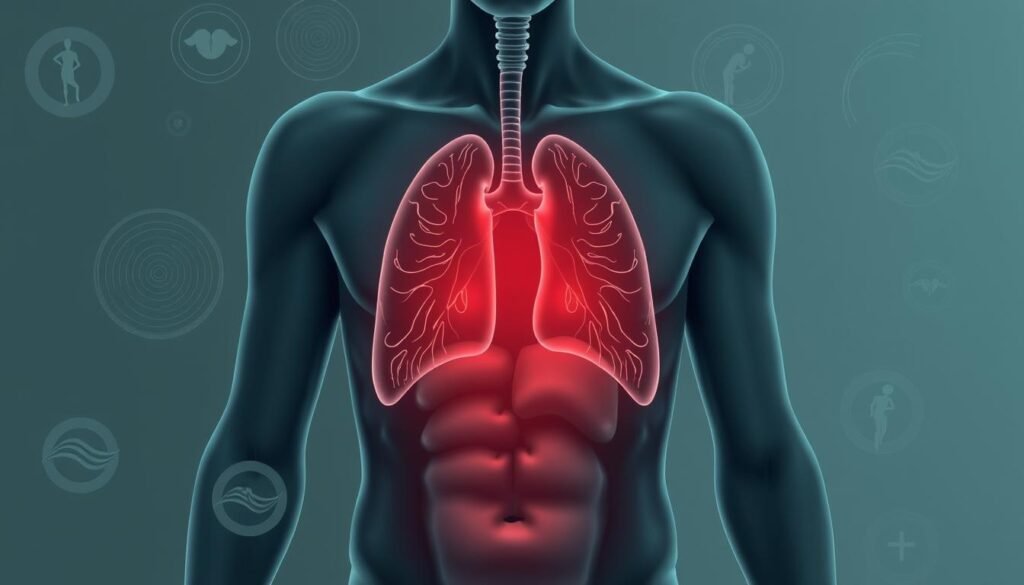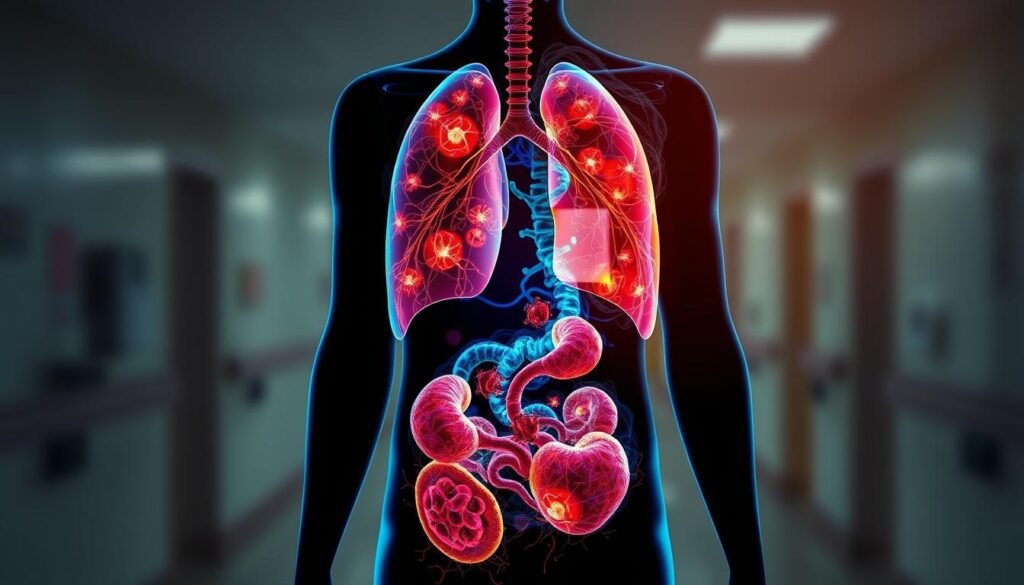In 2021, lung cancer was behind nearly 132,000 deaths in the United States. This accounts for 22% of all cancer deaths. Many people don’t know that lung cancer can also cause abdominal pain. This pain might mean the cancer is spreading and affecting other parts of the body.
Lung cancer’s symptoms reach beyond just coughing and shortness of breath. Sometimes, those with lung cancer feel pain in their abdomen. This could point to a serious problem. Knowing about this can help catch lung cancer early, which is key for treatment.
Understanding lung cancer’s signs, including possible abdominal issues, helps grasp the disease’s complexity. Recognizing these symptoms is the first step. This awareness helps understand lung cancer better and prevents confusion about its effects.
Key Takeaways
- Lung cancer accounted for over 132,000 deaths in the United States in 2021.
- Abdominal pain can indicate advanced lung cancer or metastasis.
- Lung cancer symptoms may vary and include unexpected signs like abdominal discomfort.
- Understanding these symptoms is crucial for early detection and treatment.
- Proper medical evaluation of any persistent symptoms is necessary.
The Connection Between Lung Cancer and Abdominal Pain
When we talk about lung cancer and abdominal pain, it’s easy to get confused. Many people think abdominal pain just means stomach issues. But it’s key to understand that lung cancer can also cause pain in the abdomen. This happens as the cancer grows, leading to pain that might seem unrelated to the lungs. About 12% of lung cancer patients end up with cancer in their stomach too, mostly from a type known as large cell carcinoma.
Finding abdominal pain from lung cancer is unusual. This pain usually means the cancer is in a late stage. On average, people diagnosed with cancer in their stomach are around 64 years old. Almost 90% of them are men. The jejunum, part of the small intestine, is often where this pain starts. It’s followed by the ileum, another part of the intestine.
It’s very important to see abdominal pain as a possible lung cancer symptom. In studies, small bowel metastases were a rare find, seen in only 46 out of 431 autopsies. So, if you have strange stomach pains, don’t just think it’s a digestive problem. It might be something more serious like cancer.
Understanding Lung Cancer Symptoms
Lung cancer symptoms can be different for everyone. In early stages, you might not notice anything wrong. This makes knowing the symptoms very important for catching the disease early. People might have a cough that doesn’t go away, feel short of breath, or have chest pain.
As lung cancer gets worse, the symptoms are easier to spot. Besides the common signs, you could cough up blood, lose weight without trying, feel very tired, or start wheezing. Paying attention to these changes is key. They could signal a deeper health issue.
There are other, less common symptoms too. These include stomach pain, feeling sick, and swelling. This might mean the cancer is affecting other organs. If you notice these signs, see a doctor right away. Acting fast can make a big difference in treatment and care.

| Common Symptoms | Advanced Symptoms | Less Common Symptoms |
|---|---|---|
| Persistent cough | Coughing up blood | Abdominal pain |
| Shortness of breath | Unexplained weight loss | Nausea |
| Chest pain | Fatigue | Swelling |
| Wheezing | Bone pain | Digestive issues |
| New onset of respiratory infections | Nervous system changes | Clubbing of fingers |
Knowing about lung cancer symptoms is crucial. It can lead to early discovery and better ways to fight the disease. If something feels off, talk to a doctor right away. Doing so can save lives.
Can Lung Cancer Cause Abdominal Pain
Lung cancer can indeed cause abdominal pain. This symptom is often overlooked. Many patients think their discomfort is from stomach issues, not lung cancer. It’s important to see the connection between lung cancer and stomach pain. This helps in getting the right treatment.
Symptoms Indicating Abdominal Issues
People with lung cancer may have certain stomach symptoms. These include:
- Persistent dull pain
- Discomfort after eating
- Bloating or swelling in the abdomen
These symptoms can be confusing. People often think they’re just common digestive problems. But they could be signs of lung cancer causing stomach pain. Knowing these signs can help catch the disease early. This makes treatment quicker.
Referred Pain Explained
Referred pain is key in understanding how lung cancer affects us. This is when pain is felt somewhere other than where it starts. For instance, a lung tumor might cause shoulder or back pain. This happens through nerve pathways. People and doctors sometimes miss that this could be lung cancer. Knowing about referred pain helps patients talk better with doctors. It improves diagnosis.

Want more info on lung cancer symptoms? Visit this resource. Understanding stomach pain as part of lung cancer is key. It leads to better care.
Metastatic Lung Cancer and Its Effects
Metastatic lung cancer is a serious phase of lung cancer. It spreads beyond the lungs to other parts of the body. Knowing how it affects various organs, like the abdomen, is key. This helps us understand what patients go through. Often, patients with this condition have issues related to abdominal metastases.
Common Sites for Lung Cancer Metastasis
Lung cancer can spread to specific areas in the body. Important locations include:
- Liver
- Spleen
- Adrenal glands
- Bone
- Brain
Each spot can cause different symptoms when cancer forms new tumors there. This knowledge helps in figuring out if abdominal pain is from the cancer spreading.
How Abdominal Metastases Manifest
Abdominal metastases from lung cancer bring various symptoms. It depends on how severe the spread is. Common symptoms include:
- Abdominal pain
- Feeling of fullness
- Weight loss
- Swelling in the abdomen (ascites)
For instance, cancer reaching the liver might cause a swollen belly and pain. This makes diagnosis hard because it seems like other conditions. Knowing how lung cancer and the abdomen are connected is crucial. It helps with quick recognition and treatment.
Treating metastatic lung cancer early is vital. Understanding the specific ways lung cancer affects the body helps. It guides patients and doctors in focusing on the right treatment strategies.

Identifying Advanced Lung Cancer Symptoms
It’s key to spot advanced lung cancer symptoms early. This helps start treatment sooner and manage the disease better. People often notice symptoms that badly affect their day-to-day life. Here are the common signs:
- Severe fatigue – a pervasive sense of tiredness that does not improve with rest.
- Significant weight loss – unintended loss of weight, often associated with muscle mass degradation.
- Persistent pain – discomfort that can manifest in various areas, including the chest, back, and abdominal regions.
- Coughing up blood – this alarming symptom often prompts patients to seek medical advice.
- Difficulty breathing – shortness of breath that becomes increasingly troublesome.
At first, these symptoms might seem minor, like pneumonia or back problems. This can lead to late lung cancer recognition. Often, people only get a diagnosis after showing serious symptoms. Knowing these signs is vital.
Advanced lung cancer often comes as a shock. Symptoms can get worse quickly. This demands fast medical checks. Through scans and biopsies, doctors can confirm advanced lung cancer. Early symptom spotting is crucial. It helps in planning better treatments and support, improving life quality.
Understanding Cancer Pain Management
Cancer pain management improves life quality for lung cancer patients. About 1.61 million new lung cancer cases are diagnosed each year. Effective pain relief is key in their treatment. Many patients deal with chronic pain, from the cancer itself. This pain can be either nociceptive or neuropathic. Understanding pain management approaches allows for individualized treatment plans.
Different Approaches to Pain Relief
The management of cancer pain involves many strategies. The World Health Organization (WHO) has an Analgesic Ladder. It begins with non-opioids like paracetamol and ibuprofen, then moves to stronger medicines, if needed. About 75% of cancer patients face chronic pain. Breakthrough cancer pain can weaken ongoing opioid therapy effectiveness.
Several analgesics are used for lung cancer pain management:
- Paracetamol
- Ibuprofen
- Codeine phosphate
- Morphine
- Oxycodone
- Tricyclic antidepressants
Aside from medication, there are other pain management techniques. Cognitive Behavioral Therapy (CBT) helps too. It deals with the mental and emotional sides of pain. Techniques include:
- Diaphragmatic breathing
- Progressive muscle relaxation
- Guided imagery
- Mindfulness
- Reframing thought patterns
- Biofeedback
- Clinical hypnosis
The Role of Palliative Care
Palliative care is key in managing cancer pain. It goes beyond treating physical symptoms. It also looks after emotional needs and overall well-being. The aim is holistic care for patients throughout their treatment. Working with pain psychologists adds more support. They help patients set and reach personal goals. This empowers them to improve life quality, even with cancer.
Effective pain relief strategies, alongside emotional and social support, make cancer pain less daunting. Patients learn to manage their pain better. This boosts their mental and physical well-being.
Pleural Effusion and Its Implications
Pleural effusion is a big issue for people with lung cancer. It means too much fluid is around the lungs. This fluid can cause shortness of breath, coughing, and chest pain. Sometimes, it also causes belly pain.
This issue shows how serious lung cancer can be. Managing it is crucial for the patient’s breathing and to know how advanced the cancer is. Lung cancer often causes pleural effusion, but other cancers can too.
To find out if someone has pleural effusion, doctors use scans and test the fluid. The fluid, called exudate, is usually thick and cloudy. It has lots of protein and LDH. Treatments include draining the fluid, putting in a small drain, or sealing the space to stop fluid build-up.
Here are some treatment options and what they mean for lung cancer patients:
| Treatment Option | Description | Potential Side Effects |
|---|---|---|
| Thoracentesis | A procedure to remove excess fluid from the pleural space. | Infection, pain, and fluid re-accumulation. |
| Tunnel Catheter | A small catheter placed to allow ongoing drainage of pleural fluid. | Infection, blockage, or misplacement. |
| Pleurodesis | A treatment aimed at sealing the pleura to prevent fluid buildup. | Fever, chest pain, and discomfort. |
Doctors may also use antibiotics, steroids, and NSAIDs. These help with symptoms and the root cause of pleural effusion. Checking how the patient is doing and continuing treatment is key.
To learn more about pleural effusion, check out these comprehensive guidelines.
The Importance of Medical Consultation
It is key to seek medical advice if you notice weird symptoms. This is especially true for abdominal pain that might be linked to lung cancer. In the U.S., a huge number of lung cancer cases are diagnosed each year. For instance, about 221,200 new cases emerged in 2015. Knowing these numbers, getting regular health checks is vital. They can help spot early signs of trouble.
Talking well with your doctor plays a big role. Patients should share all symptoms and their health past. This information greatly helps doctors figure out if it’s lung cancer. Having deep conversations means tests and scans get done quicker. If you wait too long to see a doctor, you might miss the chance for early treatment.
The American Cancer Society stresses talking about lung cancer screens. This is crucial for those 55 to 74 who’ve smoked a lot. Getting checked early if you have breathing issues can lead to a better outcome.
Knowing what symptoms to watch for is important. Things like a lingering cough, pain in the chest, or losing weight without trying are key signs. Therefore, being open and talking freely with your doctor is critical. It’s a must for anyone worried about lung cancer.
Conclusion
Lung cancer and abdominal pain are closely related. Lung cancer can cause stomach pain, especially if it spreads to the stomach area. Knowing all symptoms of lung cancer, even the unusual ones, is vital. It helps people catch issues early on.
About half of lung cancer patients have cancer spread far at their first doctor visit. This shows why knowing about your health is crucial. Symptoms like stomach pain and ongoing bleeding could be warning signs. Seeing a doctor quickly can lead to better health outcomes.
Lung cancer is the top cancer killer globally. Being aware of the less typical symptoms can greatly help patients. This awareness leads to better checks and care, improving life quality for those affected.